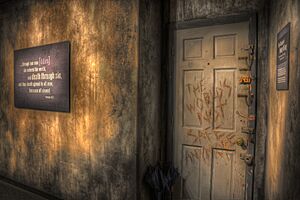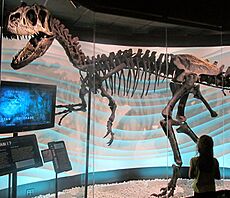Creation Museum facts for kids
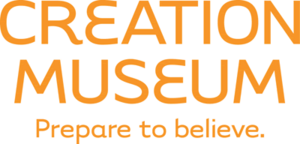 |
|

The front of the Creation Museum
|
|
| Lua error in Module:Location_map at line 420: attempt to index field 'wikibase' (a nil value). | |
| Established | May 28, 2007 |
|---|---|
| Location | Petersburg, Kentucky, U.S. |
| Type | Creation apologetics ministry |
| Visitors | 254,074 (2011) |
| Founder | Ken Ham |
| Owner | Answers in Genesis |
The Creation Museum is a museum in Petersburg, Kentucky. It presents a version of Earth's history based on a literal reading of the Book of Genesis from the Bible. The museum supports a belief called young Earth creationism. This is the idea that the universe and Earth were created by God in six 24-hour days, about 6,000 years ago.
This view is different from the scientific consensus, which states that the Earth is about 4.5 billion years old and that life developed through evolution. The museum is run by a Christian organization called Answers in Genesis (AiG).
The museum cost $27 million to build, which was raised through private donations. It opened on May 28, 2007. Inside, there is a special effects theater, a planetarium, and many exhibits, including an Allosaurus skeleton. The museum has been visited by millions of people but has also faced criticism from scientists and educators. They are concerned that the museum misrepresents science.
Contents
What Is the Creation Museum?
The Creation Museum was built to show the ideas of young Earth creationism. It uses exhibits to tell the story of the world from the first book of the Bible, Genesis. The museum's founder, Ken Ham, wanted to create a place that would support a biblical worldview.
The museum's main message is based on what it calls the "7 C's of History":
- Creation: God created the world in six days.
- Corruption: The first humans, Adam and Eve, disobeyed God, bringing sin and death into the world.
- Catastrophe: A worldwide flood, known as Noah's Flood, destroyed the Earth.
- Confusion: God created different languages at the Tower of Babel.
- Christ: God sent his son, Jesus, to Earth.
- Cross: Jesus died on the cross to save people from sin.
- Consummation: A promise of a new heaven and Earth in the future.
Many people in the United States support these beliefs, which has helped make the museum a popular attraction.
History of the Museum
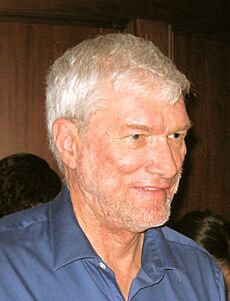
The idea for the Creation Museum began with Answers in Genesis (AiG), which was founded in 1994. The group's leader, Ken Ham, wanted to build a large museum in the United States to reach a global audience. He chose a location in Northern Kentucky because it is close to a major airport and within a one-hour flight for a large part of the U.S. population.
After finding a suitable piece of land, AiG raised $27 million from private donors to build the museum. Construction began, and the museum officially opened on May 28, 2007.
Opening Day
On its opening day, the museum welcomed about 4,000 visitors. The event received attention from news media around the world.
However, not everyone was happy about the museum's opening. A group of protesters, including scientists and educators, held a "Rally for Reason" nearby. They expressed concern that the museum's teachings were unscientific and could confuse students.
Growth and Attendance
The museum was more popular than expected. In its first year, it had over 400,000 visitors. By 2015, more than 2.4 million people had visited.
In 2016, AiG opened a sister attraction, the Ark Encounter, which features a life-sized model of Noah's Ark. This brought even more visitors to the area. In the year after the Ark opened, the Creation Museum's attendance nearly tripled to over 800,000 visitors. By 2021, the Creation Museum and Ark Encounter together had welcomed their 10 millionth visitor.
What's Inside the Museum?
The museum's exhibits are designed to guide visitors through a specific story. The tour starts by presenting two different views of the world: one based on the Bible and one based on mainstream science.
Exhibits and Displays
Visitors walk through a series of rooms that tell the story of the "7 C's."
- Creation: Dioramas show the Garden of Eden, with Adam naming animals and the creation of Eve.
- Corruption and Catastrophe: Exhibits show the consequences of Adam and Eve's disobedience, leading to a world that needed to be cleansed by a great flood. Animatronic figures are shown building Noah's Ark.
- Confusion: A display of the Tower of Babel explains how different languages and cultures began.
- Christ, Cross, and Consummation: The final rooms focus on the life and importance of Jesus.
One well-known display features a wrecking ball labeled "Millions of Years" smashing the foundation of a church. This is meant to show how AiG believes that the scientific theory of evolution has damaged Christianity.
Dinosaurs and Fossils
Dinosaurs are a major part of the Creation Museum. The museum teaches that dinosaurs and humans lived at the same time. It also suggests that dinosaurs were on Noah's Ark. The exhibits include animatronic dinosaurs and sculpted models.
In 2014, the museum added a real Allosaurus skeleton named "Ebenezer." The skeleton is nearly 30 feet long and is presented as evidence of Noah's Flood. The museum also has displays that challenge the scientific view that birds evolved from dinosaurs.
Other Attractions
The museum also has a planetarium that shows a presentation about the creation of the universe from a biblical perspective. There is also a 4D special effects theater where the seats vibrate and spray mist. Outside, there are walking trails and a large lake.
Special Events
The museum hosts many programs and events, including lectures, concerts, and family activities.
One of the most famous events was a debate in 2014 between the museum's founder, Ken Ham, and science educator Bill Nye, known for his TV show Bill Nye the Science Guy. They debated the topic of creationism versus evolution. The event sold out quickly and was watched by millions of people online. The publicity from the debate helped AiG raise money for its next big project, the Ark Encounter.
Reactions to the Museum
The Creation Museum has caused a lot of discussion. Many visitors enjoy the high-quality exhibits and appreciate the museum's message. However, it has also faced strong criticism.
Praise and Support
Supporters of the museum say it offers a valuable alternative to the evolutionary viewpoint taught in most schools and science centers. They see it as a place where families can learn about a history of the world that aligns with their faith. In 2020, the museum was voted one of the best religious museums in the country in a USA Today readers' poll.
Criticism from Scientists
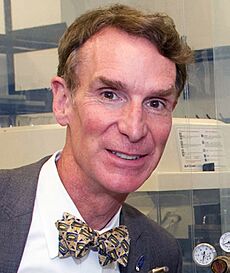
Many scientists and educators have criticized the museum for presenting pseudoscience (ideas that seem scientific but are not) as fact. Before it opened, thousands of educators and scientists signed statements expressing concern that the museum would harm science education. They argue that the museum's claims about a 6,000-year-old Earth and humans living with dinosaurs are not supported by evidence.
Critics also worry about public schools taking students on field trips to the museum. They believe that schools should not expose students to information that contradicts established science.
Is It Really a Museum?
Some people have questioned whether the Creation Museum should be called a "museum" at all. They argue that traditional museums display real artifacts and present information based on scientific research. Since many of the Creation Museum's exhibits are recreations designed to illustrate a religious story, some critics have called it the "Anti-Museum" or "Ken Ham's fabulous fake museum."
In response, Ken Ham has argued that the Creation Museum fits the dictionary definition of a museum and that it is simply presenting a different worldview.
Images for kids
See also
- Creation Evidence Museum
- ICR Discovery Center for Science & Earth History
- List of creation myths
- Religious cosmology





